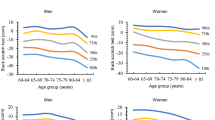Abstract
Our aim was to develop an age scale for the assessment of functional fitness in older women. The subjects were 430 older Japanese ambulatory women. They were divided into three groups: (a) less active (N=373, age 72.5±6.7 years); (b) active (N=23, age 71.0±5.4 years); and (c) sedentary (N=34, age 72.9±4.7 years). The less active group was used for the development of the instrumental activities of daily living (IADL) age equation, while data from active and sedentary groups were utilized for the assessment of the criterion-related validity. Seventeen functional fitness variables were selected as test items related to IADL. IADL were defined as extra activities people engaged in during daily living, such as preparing meals, housecleaning activities, and washing. After applying the first principal component analysis to the correlation matrix among the 17 items, the following IADL age equation was obtained: IADL age = - 0.43X1 - 0.57X2 - 0.32X3 + 0.37X4 + 0.37CA + 61.88, where X1 = arm curl (n / 30 s), X2 = moving beans with chopsticks (n / 30 s), X3 = functional reach (cm), X4 = walking around two cones (s), and CA = chronological age (years). The mean IADL age of the less active group (72.2±8.4 years) obtained from this equation was matched with their mean CA. The mean IADL age of the active group (66.0±3.2 years) was significantly lower than their mean CA (71.0±5.4 years, p<0.05), and the mean IADL age of the sedentary group (79.1±6.0 years) was significantly higher than their mean CA (72.9±4.7 years, p<0.05). In conclusion, the criterion-related validity of the IADL age equation was clearly demonstrated as a means to assess the functional fitness required for IADL in older Japanese women.
Similar content being viewed by others
References
Japanese Management and Coordination Agency: 1998 (URL: http://www.stat.go.jp).
Japanese Ministry of Health and Welfare: 1998 (URL: http://www.mhw.go.jp).
World Health Organization: The uses of epidemiology in the study of the elderly. Report of a WHO Scientific Group on the Epidemiology of Aging. Geneva, 1984.
Spirduso W.W.: Physical dimensions of aging. Human Kinetics, Illinois, 1995.
Dubina T.L., Mints A.Y., Zhuk E.V.: Biological age and its estimation. III. Introduction of a correction to the multiple regression model of biological age and assessment of biological age in cross-sectional and longitudinal studies. Exp. Gerontol. 19: 133–143, 1984.
Furukawa T.: Assessment of the adequacy of the multiregression method to estimate biological age. In: Balin A.K. (Ed.), Human biological age determination. CRC Press, Boca Raton, 1994, pp. 471–484.
Kim H.S., Tanaka K.: The assessment of functional age using “Activities of daily living” performance tests: A study of Korean women. J. Aging Phys. Activ. 3: 39–53, 1995.
Tanaka K., Kim H.S., Yang J.H., Shimamoto H., Kokudo S., Nishijima T.: Index of assessing functional status in elderly Japanese men. Appl. Hum. Sci. 14: 65–71, 1995.
Duncan P.W., Weiner D.K., Chandler J., Studenski S.: Functional reach: A new clinical measure of balance. J. Gerontol. 45: M192–M197, 1990.
Kimura M., Hirakawa K., Okuno T., Oda T., Morimoto T., Kitani T., Fujita D., Nagata H.: An analysis of physical fitness in the aged people with fitness battery test. Jpn. J. Phys. Fitness Sports Med. 38: 175–185, 1989.
Nakao M., Inoue Y., Murakami H.: Aging process of leg muscle endurance in males and females. Eur. J. Appl. Physiol. 59: 209–214, 1989.
Osness W.H.: Assessment of physical function among older adults. In: Leslie D.K. (Ed.), Mature stuff: Physical activity for the older adult. American Alliance for Health, Physical Education, Recreation, and Dance, Virginia, 1989, pp. 93–118.
Tokyo Metropolitan University: References in Japanese physical fitness. Fumaido, Tokyo, 1989.
Shigematsu R., Kim H.K., Kim H.S., Tanaka K.: Reliability and objectivity of the test items to assess functional fitness required for performing activities of daily living in older adult Japanese women. Jpn J. Physiol. Anthropol. 3: 13–18, 1998.
Nunnally J.C.: Test and measurement. McGraw-Hill, New York, 1959.
Nakamura E., Moritani T., Kanetaka A.: Biological age versus physical fitness age in women. Eur. J. Appl. Physiol. 61: 202–208, 1990.
Tanaka K., Matsuura Y., Nakadomo F., Nakamura E.: Assessment of vital age of Japanese women by principal component analysis. Jpn. J. Phys. Edu. 35: 121–131, 1990.
Gallahue D.L.: Motor development and movement experiences for young children. John Wiley & Sons, New York, 1976.
Kruger H., Kruger J.M.: Movement education in physical education. Wm. C. Brown, Iowa, 1977.
Koyano W., Hashimoto M., Fukawa T., Shibata H., Gunji T.: Competence in the elderly living at home. Distribution of the scores of competence. Jpn. J. Public Health 40: 468–473, 1993.
Hinohara S.: Measurement of physiological age. Jpn. J. Geriatr. 2: 116–119, 1965.
Clark J.W.: The aging dimension: A factorial analysis of individual differences with age on psychological and physiological measurements. J. Gerontol. 15: 183–187, 1960.
Borkan G.A., Norris A.H.: Assessment of biological age using a profile of physical parameters. J. Gerontol. 35: 177–184, 1980.
Heikkinen E., Kiiskinen A., Kayhty B., Rimpela L., Vuori I.: Assessment of biological age: Methodological study in two Finnish populations. Gerontologia 20: 33–43, 1974.
Nakamura E., Moritani T., Kanetaka A.: Biological age versus physical fitness age. Eur. J. Appl. Physiol. 58: 778–785, 1989.
Rikli R., Busch S.: Motor performance of women as a function of age and physical activity level. J. Gerontol. 41: 645–649, 1986.
Author information
Authors and Affiliations
Corresponding author
Rights and permissions
About this article
Cite this article
Shigematsu, R., Tanaka, K. Age scale for assessing functional fitness in older Japanese ambulatory women. Aging Clin Exp Res 12, 256–263 (2000). https://doi.org/10.1007/BF03339845
Received:
Accepted:
Published:
Issue Date:
DOI: https://doi.org/10.1007/BF03339845




